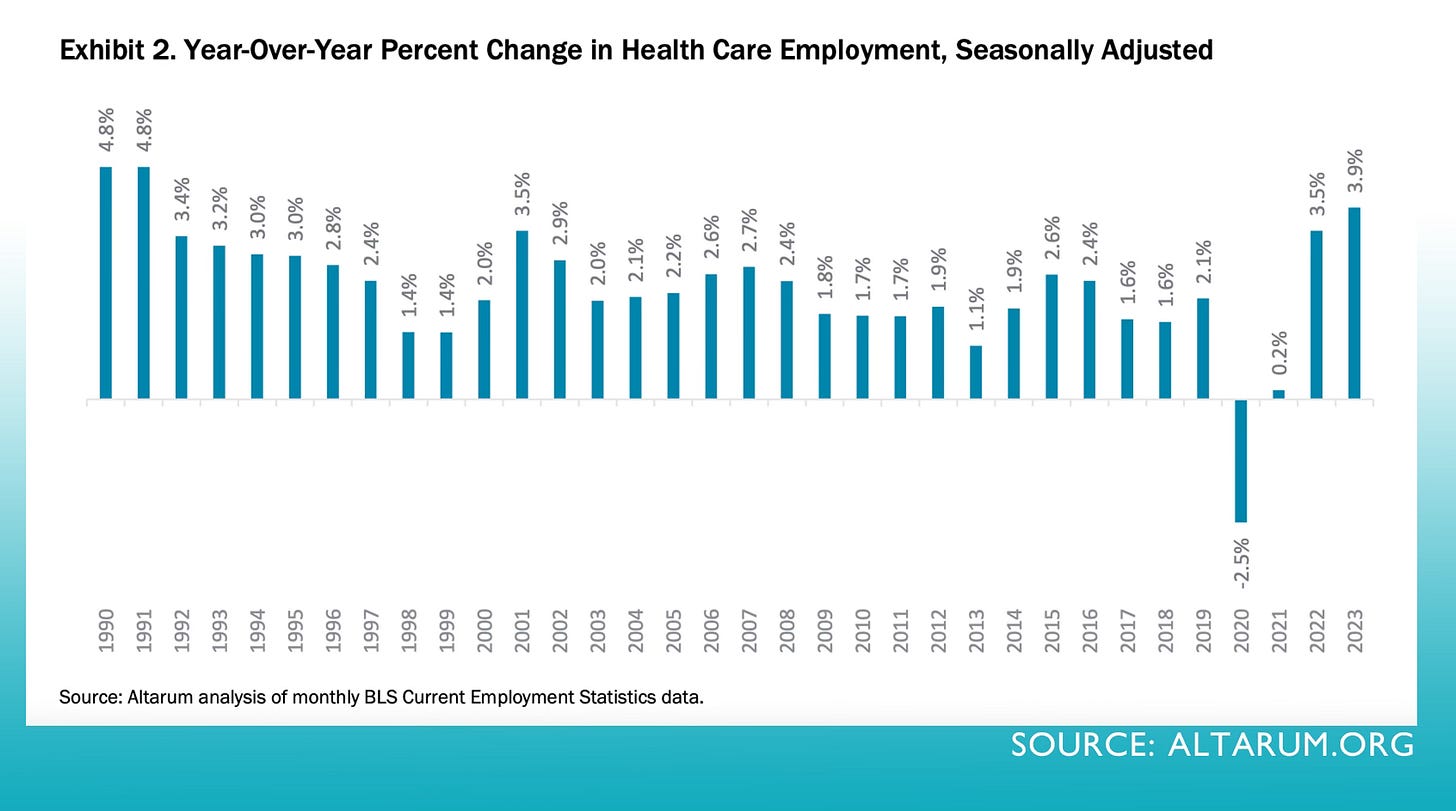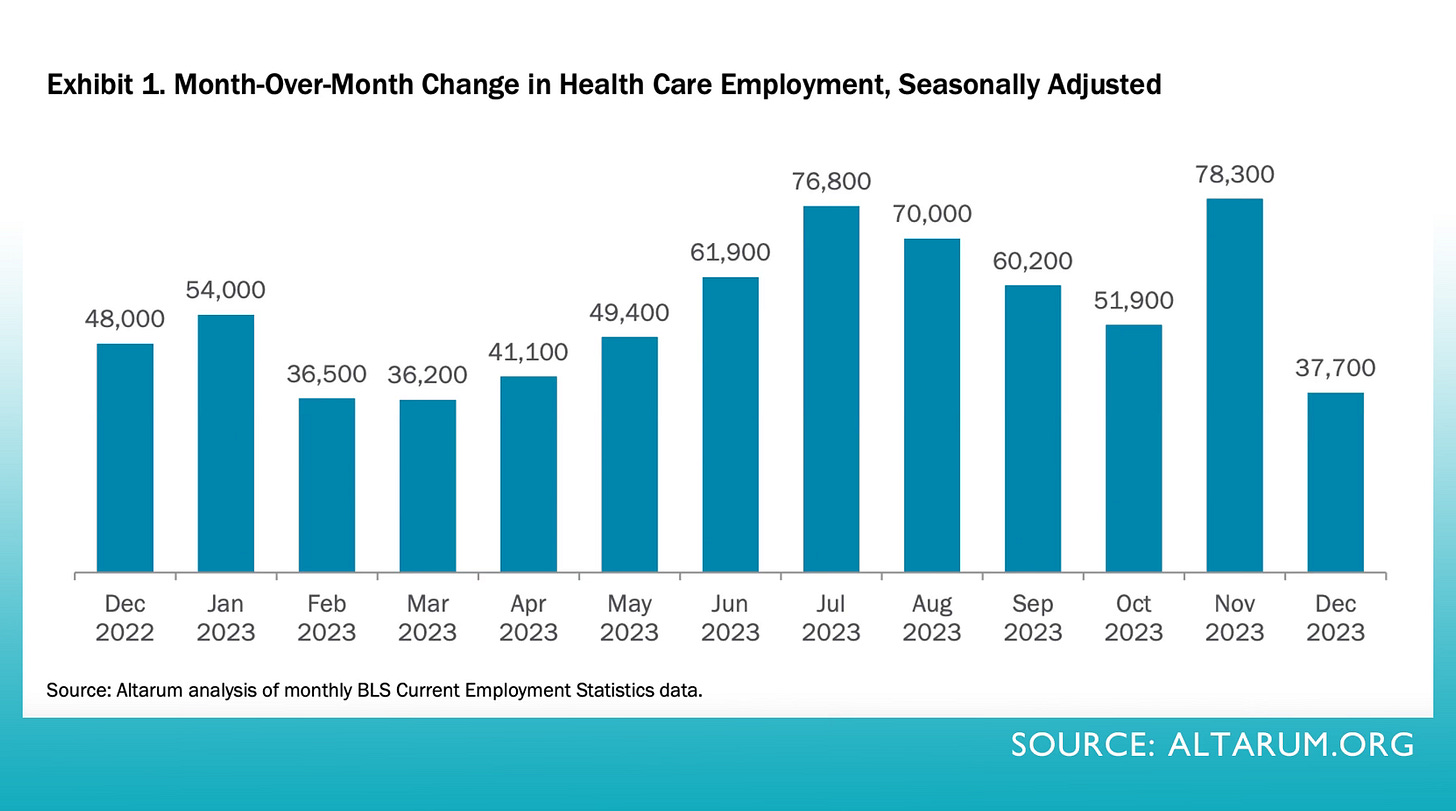Healthcare job growth in 2023 hit a 32-year high
Also: North Carolina eyes a new funding model for community colleges based on workforce needs, not full-time enrollments
Healthcare job growth rose more last year than it has in over three decades — which is likely not that surprising to anyone working in the sector.
An Altarum analysis of Bureau of Labor Statistics data showed that healthcare employment grew by 3.9% in 2023, which is about 2.5 times the growth rate (1.5%) across the entire U.S. economy for last year.
PS: The Altarum research PDF is chock-full of graphics showing how healthcare employment, salary growth and more have tracked over the decades and how those rates compare with the economy as a whole.
“The last time healthcare experienced a rate of employment growth above 3.9% was in 1991, when the rate was 4.8%,” reported Becker’s Hospital Review.
January’s jobs report continued the trend, with healthcare adding 70,300 jobs, nearly double the previous month’s total.
The analysis indicates “a trend away from the workforce numbers seen during the pandemic,” Becker’s wrote. “Hospital employment has grown by 192,700 jobs, or 3.7%, since February 2020, while employment in ambulatory care settings has grown by 9.2%.
“Still, nursing and residential care employment, although steadily increasing since January 2022, remains 4.6% below pre-pandemic levels, a trend Altarum said is likely due to nursing home closures, lower resident censuses and staffing shortages.”
Pew Research on aging population has serious implications
New numbers from Pew Research out last month show that by 2054, the number of Americans 100 or older will more than quadruple, and the number of adults age 65 and older will make up a quarter of the U.S. population.
A new blog from MedCerts Partner Solutions explains the implications of this for the healthcare industry and the larger workforce.
It seems obvious that a population that includes significantly more older folks would require more healthcare practitioners, but the impact is actually far bigger than you might think.
People over 85 access healthcare three times more than those 65–74, and the latter group demands significantly more care than the average population, research shows.
“By any metric, the US is looking at a sharp rise in the demand for healthcare over the next few decades,” the blog says.
And although the industry is adding jobs like gangbusters (see above), it’s nowhere near keeping up with current demand, let alone demand that is projected to quadruple in the next few decades.
By next year, for example, the shortfall of home health aides will hit 400,000, according to Mercer projections. Nearly every type of healthcare job is expected to grow significantly faster than the labor pool: health IT and medical registrar jobs are expected to grow 16%; home health and personal care workers, 22%; nurse anesthetists, nurse midwives, and nurse practitioners, 38%.
Read the full blog here.
(Transparency alert: MedCerts is the sponsor of Healthcare Workforce Report.)
North Carolina plan would pin community college funding to workforce needs
A new report from Inside Higher Ed details a somewhat radical — in the context of academia and longstanding, slow-changing funding models — proposal to overhaul the way North Carolina community colleges are funded to put more emphasis on workforce development.
State CC officials will vote on the plan, dubbed Propel NC, later this month, and then the state legislature will be asked to approve it in April. EducationNC reports the proposed changes were unanimously supported by members of the North Carolina Association of Community College Presidents.
According to EducationNC and Inside Higher Ed:
The state has been using a “tier-based” model in which colleges are largely funded based on full-time enrollments. Courses are divided into four tiers, based on how expensive they are to offer, which receive different amounts of funding.
Under the proposed model, funding based on FTE would remain in place, but the current FTE tiers would shift to “workforce sectors” instead. The sectors include health care, engineering and advanced manufacturing, transportation, and information technology.
It would group credit and noncredit courses in the same fields into the same sectors. For example, a nursing course would bring in the same amount of funding whether it’s part of a degree program or a non-credit certificate program.
The 16-person Propel NC work group says this will move the NCCCS toward a labor-market driven model of community college programs. Under the proposed model, courses will be ranked and valued by statewide salary job demand data. The course rankings will be updated every three years.
The anticipated cost for this part is approximately $68.6 million, according to the system.
Lt. Gov. Mark Robinson, an ex-officio member of the State Board, expressed his support for the plan.
“Moving from tiers-based to labor-market driven, I would suppose that would give us a lot more flexibility, so I think that’s very good,” Robinson said. “Community colleges are going to be essential (to the economy)… so I’m glad to see the work that’s going on.”
Read more about the Propel NC plan here.
Shout-out to Healthcare Workforce Report sponsors
The Healthcare Workforce Report newsletter is generously supported by MedCerts.
For information on supporting HWR, email HealthcareWorkforce@substack.com.







